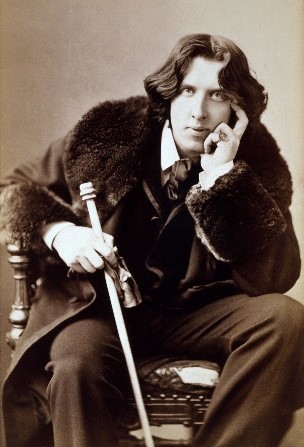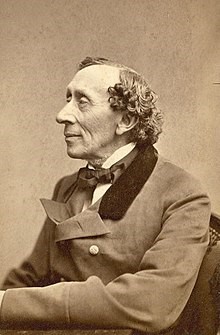
This project promotes open access materials and has been funded with support from the European Commission - Erasmus+ program. These materials reflect the views only of the author, and the Commission cannot be held responsible for any use which may be made of the information contained therein.
[Project Number: 2016-1-HR01-KA201-022159]
![]()
Book title
The Happy Prince And Other Stories
Author
Oscar Wilde

Bibliographic information
Penguin Books, 1994
Links (adaptations, reviews, full texts etc.)
· http://www.wilde-online.info/the-selfish-giant.html
· https://www.youtube.com/watch?v=btNVUWikg7M
Theme
Relationships between people, building walls is not a solution, we should destroy them instead
Short summary
The Giant expels kids from his garden and with them all the good things leave. After some time the Giant opens his heart, lets the kids in and he can feel happy again playing with them. When he dies his good deeds take him to the Paradise.
Why is the story appropriate for the targeted groups of RSP readers?
It reflects political, historical and social themes, social diversities, refers to current migrant situation
What are the distinguished readers interests reflected by this book/story?
-
Why is this story motivational for the pupils?
A very popular short story for generations of readers.
Is there a historical, political, multi/inter cultural, migrant or similar context recognized in this book/story?
We could find there the migrant theme - a group of people intervening other people's areas, building walls etc.
Is there a principle of inclusion reflected in this book/story and does it promotes understanding of cultural diversities and heritage?
The story promotes the importance of understanding and helping other people, and also to be a part of community.
Title of Activity
The Brave Thin Soldier
Description of educational activity
Duration: 90 minutes
Pupils’ age: 15-19
Organization of the class of pupils: group work
The aim of the lesson: The aim of the lesson is to improve the reading literacy of the students. The students cooperate and help each other when solving various tasks.
Support materials: The number of the tools according to the number of the groups.
- Scarves.
- The text of the story cut in eight pieces.
- Packages with pictures.
- Packets with three riddles.
- Picture puzzles.
- Sheets of paper for making ships.
- Papers with math tasks.
Activities:
- The students are divided into groups of 4. The students learn that each of them suffers from a kind of disability – one is blind, one is dumb, one is without legs, one is without arms. They will exchange their disabilities after completing every other tasks.
- Each group gets Task 1 – a package with a picture which should be described by the blind person. After the task has been completed, the group gets the first part of the story.
- Each group gets Task 2 – a set of three riddles. After the task has been completed, the group gets the first part of the story.
- Each group gets Task 3 – a picture puzzle which should be put together. After the task has been completed, the group gets the first part of the story.
- Each group gets Task 4 – The dumb person gets the instructions to the following task which should be completed by the whole group. After the task has been completed, the group gets the first part of the story.
- Each group gets Task 5 – they have to make a paper ship. After the task has been completed, the group gets the first part of the story.
- Each group gets Task 6 – they write a love poem about a one-leg tin soldier and a beautiful paper lady. After the task has been completed, the group gets the first part of the story.
- Each group gets Task 7 – a math task. After the task has been completed, the group gets the first part of the story.
- Each group gets Task 8 – they make three living pictures involving all the group members and illustrating three moments from the story. After the task has been completed, the group gets the first part of the story.
- The students lose all their disabilities. They stay in their groups and discuss their ideas about the story end. They should choose one idea and illustrate it using one more living picture.
- Discussion – their experience from sorting out the tasks with different disabilities.
Evaluation and assessment method:
- Throughout the lesson, ensure that your students are backing up their choices with accurate supporting details.
- Teacher's observations of student preparedness, student work samples, and participation in group activities and discussions.
- In order to evaluate and assess the effective impact of the previous activities upon the students, all of them should actively participate in the final discussion.
Effect of the activity on RSP reading:
Practices that support students´ choice, collaboration, and shared control of learning outcomes can be linked to self-expressed interest in reading and engaged reading behaviours. Teachers can organize reading instruction to develop self-efficiency, competence, and engagement in teenage students.
Connection to curriculum
Grade: 1 – 4 grade of secondary studies
Curriculum: The study of literature is focused on reading and comprehending literary texts of historical and cultural importance and relevancy either in the world or Czech literature. Students are taught to work with texts and information in different ways, to adopt the processes of analysis, synthesis, induction, deduction, generalization, abstraction, specification, comparison, organization, selection. The students should be able to interpret, summarize and evaluate the texts.
Knowledge:
- Understand the stages of development of a hero
- Develop reading fluency
- Improve reading comprehension
- Organise information in a specific way
Skills:
- Use imagination, fantasy
- Distinguish reality and fantasy
- Make predictions, deductions
- Use logical thinking
- Compare and contrast
- Summarize
- Work effectively in groups, respecting others
Competences:
- Make connections between fiction and real life or personal experiences
- Be able to visualise material read
- Follow specific instructions and conventions
- Evaluate evidence
- Support and justify an opinion
Bibliographic reference to be used during the activity
Hans Christian Andersen
Publisher: https://americanliterature.com
Year of issue: 2016
Digital sources
A short video based on the story: https://www.youtube.com/watch?v=wsYU8RJ4B7w
Results
The expected outcomes of the lesson are:
- The students will be able to cooperate in groups and overcome model physical and psychical difficulties.
- The students cooperating in groups have to solve various tasks from different fields.
- The students experience life with different disabilities which will help them understand problems of other people.
Recommendations
Both the teaching method and the text can help in increasing students’ interest in reading. The activities for reading this story offer more active approach which is in contrast with what we normally connect with reading. The students get the text in smaller pieces which more suitable for RSP readers. The teacher monitors the students so as to make sure they cooperate effectively.
Book title
The Brave Tin Soldier
Author
Hans Christian Andersen

Bibliographic information
https://americanliterature.com
Links (adaptations, reviews, full texts etc.)
https://americanliterature.com/author/hans-christian-andersen/short-story/the-brave-tin-soldier
Theme
Coincidence, fate, love, self-confidence, happy end
Short summary
Tin Soldier falls in love with a little dancer, however, he is not confident enough to talk to her. One day the Soldier falls out of a window and his adventure begins. Through many twists of fate he gets back to his room. What seems to be a happy end turns into a horror end.
Why is the story appropriate for the targeted groups of RSP readers?
It reflects social themes, social diversities
What are the distinguished readers interests reflected by this book/story?
-
Why is this story motivational for the pupils?
Pupils like reading allegoric stories, this one also turns into a horror in the end.
Is there a historical, political, multi/inter cultural, migrant or similar context recognized in this book/story?
-
Is there a principle of inclusion reflected in this book/story and does it promotes understanding of cultural diversities and heritage?
The story deals with the importance of being accepted by society, need for love and happiness.
Title of Activity
The Aged Mother
Description of educational activity
Duration: 180 minutes
Pupils’ age: 15-19
Organization of the class of pupils: individual/group work
The aim of the lesson: The aim of the lesson is to improve the reading literacy of the students. The students revise their opinions of the elder people and their relationships with them. The students also gain some basic knowledge of typical features of Japanese folk tales. Another goal is to make the pupils develop their imagination and express themselves using metaphorical language and different art activities.
Support materials: The text of the story, paper sheets, crayons, simple musical instruments.
Activities:
- The students work in groups discussing the following questions. Where does youth end? How does one become adult? Where does the old age begin?
- What are the main purposes/contents of these life periods. Prepare a living picture for each life period.
- What are the pros and cons of every life period?
- The students read the text. Find four key moments in the story and illustrate each by one of the following:
- a spoken dialogue
- a picture drawn on a sheet of paper
- a song
- a pantomime
- What can you do if you disagree with an official order?
- Can you think of any order/rule that you find stupid?
- Compose a petition text against a specific order/rule.
- Prepare banners with slogans for a demonstration.
Evaluation and assessment method:
- Throughout the lesson, ensure that your students are backing up their choices with accurate supporting details.
- Teacher's observations of students’ participation in group activities and discussions.
Effect of the activity on RSP reading: Practices that support students´ imagination, choice, collaboration, and shared control of learning outcomes can be linked to self-expressed interest in reading and engaged reading behaviour.
Connection to curriculum
Grade: 1 – 4 grade of secondary studies
Curriculum: The study of literature is focused on reading and comprehending literary texts of historical and cultural importance and relevancy either in the world or Czech literature. Students are taught to work with texts and information in different ways, to adopt the processes of analysis, synthesis, induction, deduction, generalization, abstraction, specification, comparison, organization, selection. The students should be able to interpret, summarize and evaluate the texts.
Knowledge:
- Improve reading comprehension
- Organise information in a specific way
- Able to set an official requirement
Skills:
- Make predictions, deductions
- Compare and contrast
- Summarize
- Work effectively in groups, respecting others
- Improve the social skills
Competences:
- Think in social context about life or personal experience of different people
- Be able to visualise material read
- Follow specific instructions and conventions
- Support and justify an opinion
Bibliographic reference to be used during the activity
Matsuo Basho
Publisher: https://americanliterature.com
Results
The expected outcomes of the lesson are:
- The students will be able to understand different life situations in social context.
- To think about rules, their importance and the importance of following them.
- To be able to set an official requirement backed with relevant opinions and evidence.
- To offer observations, make connections, speculate, interpret, and raise questions in response to the story.
Recommendations
Both the teaching method and the text can help in increasing students’ interest in reading. This text promotes a relationship between a child and his/her mother.
The teacher monitors the students so as to make sure they cooperate effectively.
Contact
X gimnazija ''Ivan Supek''
Ul. Vjekoslava Klaića 7
10000
Zagreb
E-mail: partners@handbook4rspreaders.org










